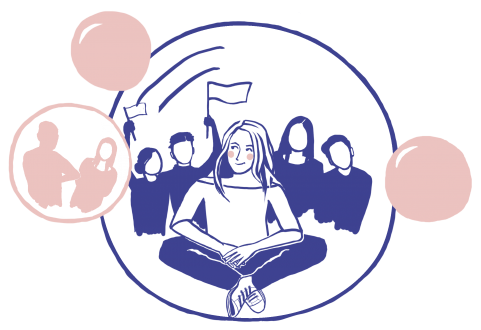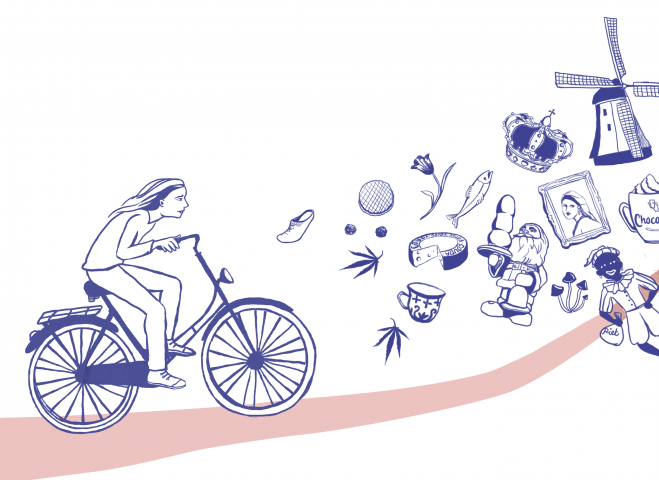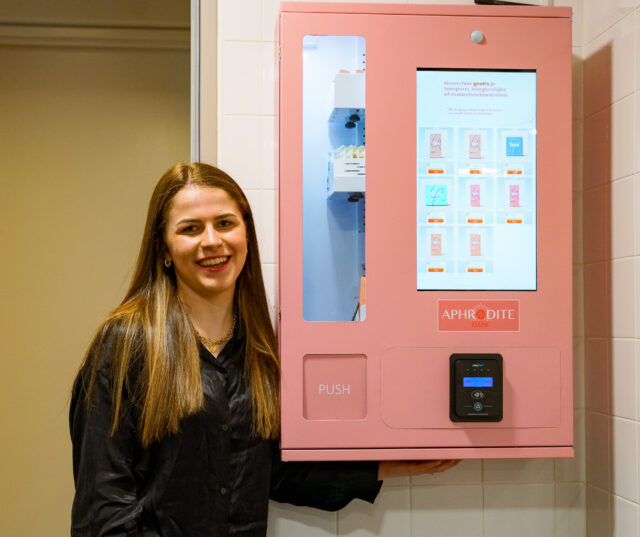The Netherlands: All you need to know when starting your adventure
Gepubliceerd: 24 September 2018 • Leestijd: 5 minuten en 2 seconden • Longread Dit artikel is meer dan een jaar oud.In 2014 Katja (24) went on an adventure in the Netherlands. She left her German hometown of Stuttgart to study illustration at the Willem de Kooning Academy. In the past few years she has picked up quite a few tricks to manage living with the Dutch, and is willing to share them.

Text & illustration: Katja Hermann
The Netherlands: An elbow society?
When I arrived in the Netherlands, I painfully noticed how straightforward and driven the Dutch are. As I was looking to find my way, I almost got run over by tall, neatly dressed businessmen shouting Godverdomme! at me for standing in their way.

I had never seen people so eager to get to work at six o’clock in the morning.
Trying to make my way to the train I realised that elbows, and when needed swearwords, are part of Dutch etiquette. I silently said goodbye to the rule ‘ladies first’ as a young man elbowed me in the ribs to take the seat I was going to settle down on. To complete my welcome, the Netherlands hugged me with cold windy fingers and sprayed tiny needles of rain into my exhausted face.
Brutal honesty
It was a good welcome, as things really could only get better from there. And they did. A few years later I found myself in the train, smiling at the beautiful tulip fields and realising that, right there in a full train, as an elbow was piercing my ribs I felt like I was coming home. No matter how crude the Dutch seemed to be back when I arrived, I have gotten to know them as friendly and open individuals. It is a special kind of friendliness which, mixed with an almost brutal honesty, feels genuine and real.
Doooiee, doooiee
 There are certain behaviours I noticed over the years, which are very funny to me as a foreigner. One of them is the way the Dutch greet each other, which is so drastically different for men and women that it always makes me laugh to myself. When Dutch women greet each other, they do so by kissing the air besides each other’s cheeks three times. As they say goodbye, they pull their faces into sweet smiles chanting ‘doooiee, doooiee’ in a very feminine voice. Men, on the other hand, greet and say goodbye to each other with a loud ‘hooii’, while smashing each other’s backs. As if this man-hug wasn’t enough of an outburst of masculinity, they make sure not to hold each other too close – just to reassure others and mainly themselves of their heterosexuality.
There are certain behaviours I noticed over the years, which are very funny to me as a foreigner. One of them is the way the Dutch greet each other, which is so drastically different for men and women that it always makes me laugh to myself. When Dutch women greet each other, they do so by kissing the air besides each other’s cheeks three times. As they say goodbye, they pull their faces into sweet smiles chanting ‘doooiee, doooiee’ in a very feminine voice. Men, on the other hand, greet and say goodbye to each other with a loud ‘hooii’, while smashing each other’s backs. As if this man-hug wasn’t enough of an outburst of masculinity, they make sure not to hold each other too close – just to reassure others and mainly themselves of their heterosexuality.
Not that they frown upon gays. Dutch society is very accepting, and discrimination is illegal and socially unacceptable. But even though the Netherlands is a very progressive country, I have also encountered people who were less tolerant. There seems to be quite a difference between big cities such as Amsterdam, Rotterdam and Utrecht, and smaller towns. Once, in the supermarket of a small town, an older man shouted at me and my friend for speaking in another language. Another time, people on the train made fun of ‘those stupid foreigners’, only to freeze in shame when I confronted them in Dutch. But aside from these incidents, I was usually welcomed with open arms – or elbows for that matter.
Elbows and swearwords are part of Dutch etiquette.
Dutch cuisine
Dutch cuisine is not for the health-conscious among us. The Dutch like deep-fried snacks and other fatty delicacies. At various corners you will find stores that offer snacks with funny names like bitterballen, frikandel, kaassoufflé and more. Fries are also a specialty in the Netherlands – at some snack bars they are prepared from freshly cut potatoes and offered with a large variety of sauces and toppings. They have patatje oorlog (literally, war fries), consisting of fries topped with mayonnaise, satay sauce (peanuts are another thing the Dutch like) and raw onions. Maybe the name describes the war of different flavours fighting for attention? Or the fight of the fries for air because they are drowning in sauce? Who knows!
Caries-inducing things
 The Dutch also like to soak their teeth in caries-inducing things. Pancakes and waffles are enjoyed in all shapes and sizes. A typical Dutch thing are poffertjes, essentially tiny pancakes topped with powdered sugar, butter or chocolate sauce. You have probably already come across stroopwafels, which taste heavenly when freshly made. Stroopwafels are thin waffles filled with caramel syrup. On special occasions the Dutch like to eat tompoezen: cream-filled pastries with a pink topping that are impossible to eat without making a mess. No one really knows how to eat them properly. For celebrations such as King’s Day and Liberation Day, tompoezen are orange to show patriotism.
The Dutch also like to soak their teeth in caries-inducing things. Pancakes and waffles are enjoyed in all shapes and sizes. A typical Dutch thing are poffertjes, essentially tiny pancakes topped with powdered sugar, butter or chocolate sauce. You have probably already come across stroopwafels, which taste heavenly when freshly made. Stroopwafels are thin waffles filled with caramel syrup. On special occasions the Dutch like to eat tompoezen: cream-filled pastries with a pink topping that are impossible to eat without making a mess. No one really knows how to eat them properly. For celebrations such as King’s Day and Liberation Day, tompoezen are orange to show patriotism.
Stroopwafels taste heavenly when freshly made.
Language: Don’t get lost in translation
Since the Netherlands is such a small country, its people need to communicate outside of its borders. Most youngsters are completely fluent in English and as a foreigner it is entirely possible to study, work and live in the Netherlands without ever needing to learn the language. Still, I think it is very important to learn Dutch if you are staying for a longer time, otherwise a whole aspect of the culture gets lost in translation. I have also seen that even though Dutch and international students study together, they stay quite separated in their social interactions. This is probably because most people still prefer talking in their mother tongue in their free time.
No English please
You kick-start your Dutch by taking a language course, for instance at Erasmus University. Courses are great, but make sure you practice everything you learned in real life, as that will help you the most. In the process of learning Dutch you will have to keep reminding your surroundings of your aim to learn the language, because they automatically switch to English if someone is not fluent. This is very polite but can make it difficult to stick to your practice. I never encountered much negativity when it came to my accent. Really, I think the Dutch are very positive and ready to help if someone learns their language.
– Erasmus University: Language & Training Centre (eur.nl/onderwijs/taal-trainingscentrum)
– Volksuniversiteit Rotterdam (volksuniversiteitrotterdam.nl)
How to battle homesickness
No matter how much you love your new life in the Netherlands, there will be times when you miss home. Here are some tried-and-tested tips to battle homesickness:
1. Food
Nothing will give you a better feeling of being home than eating your favourite dish (Käsespätzle in my case). Invite your new friends and share this part of your roots with them.
2. Skype
Don’t wait for family and friends to call. It is best to organise your social contacts at home and schedule regular Skype dates.
3. Homies
Find people from your country. Even if they are people who at first glance seem to have nothing in common with you, they are your homies after all! And it feels amazing to talk in your mother tongue to someone who gets it. Invite your friends from home to come visit you. It will give them an insight on what your life is like now and will make it easier for them to picture your situation. Plus you get the bonus of seeing the place you moved to with fresh eyes again.
4. Books
Books are great at teleporting you to other places. Dutch libraries are incredibly well-stocked with foreign literature, so it shouldn’t be too difficult to find a book in your language. TV shows, movies or music are great too.

Nothing will give you a better feeling of being home than eating your favourite dish.










i can tell you how to eat Tompoezen, properly.
Just take the top-part of the Tompoes, eat it or lay it under the downpart of the Tompoes.
That way, you won`t get to many sticky fingers or a mess.
Leuk verhaal en leuk/mooi geïllustreerd.
Ook aan te raden, een kei leuk boekje: Why the Dutch are different. Een beschrijving van een Engelsman die in Nederland woont en onze dagelijkse gewoontes koppelt aan onze geschiedenis. Vlot geschreven en komisch.
Why the Dutch are different van Ben Coates
Eerst de slagroomstreep, dan de roze laag, dan de room en als laatste de bodem. Zo eet je hem.
Jullie doen het allemaal verkeerd!
Eerst eet je de slagroomstreep. Dan leg je de roze laag terzijde. Dan schuif je de bodem mét de room naar binnen en dán pas eet je de roze laag.
Althans, dat is de methode voor beginners (en voor hen die geen bestek ter beschikking hebben)! De gevorderde tompoezen-eter doet het, voor de ultieme smaakbeleving, als volgt:
Eerst eet je de slagroomstreep. Dan leg je de roze laag terzijde. Dan haal je (met een vork) de bovenste helft van de room van de bodem en legt deze eveneens terzijde. Dan schuif je de bodem met de onderste helft van de room naar binnen. Dan draai je de roze laag om tussen duim en vingers (zodat het glazuur niets raakt en dus nergens aan kan blijven plakken). Dan doe je de terzijde geschoven helft van de room op de ‘koekkant’ van de roze laag. Dan schuif je ook deze laag naar binnen.
Je gebruikt de roze bovenkant als een soort nacho om de room mee op te lepelen 😉